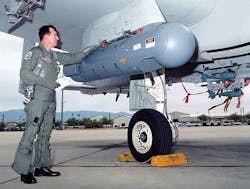Air Force takes up open-systems standards for ISR sensor pods in hopes of spreading military-wide
PHOENIX, 22 Jan. 2015. U.S. Air Force avionics experts are spearheading a initiative to define a standard electronics architecture for complex intelligence, surveillance, and reconnaissance (ISR) sensor pods on military aircraft.
The project, called Sensor Open Systems Architecture (SOSA), involves high-data-rate and high-performance multi-intelligence ISR sensor pods. The initiative is being led by the Air Force Research Laboratory and is expected to influence sensor pod design on U.S. Army and Navy aircraft, as well.
The SOSA initiative, begun one year ago, describes "an architecture that handles very high data rates, and is upgradable," said Patrick Collier, senior electrical research engineer and deputy program manager at the Air Force Research Laboratory at Kirtland Air Force Base, N.M. Collier outlined the SOSA program this week at the Embedded Tech Trends conference in Phoenix.
Similarly, the Sensor Open Systems Architecture (SOSA) is designed for use across the intelligence, surveillance, and reconnaissance (ISR) community to maximize platform and system affordability, re-configurability, performance, and reuse.
Related: Navy chooses multi-sensor electro-optical targeting pods from FLIR for copters and UAVs
Develop an open systems, agile, platform-agnostic ISR payload architecture which will serve as an enabler for future ISR systems and associated upgrades. Of particular interest is an architecture that handles the demanding data requirements of ISR and accommodates future upgrades.
The SOSA initiative is an attempt by the Air Force to get away from closed-system proprietary designs for complex ISR sensor pods for military aircraft to reduce costs, cut development time, and ease systems upgrades and technology insertion.
Although the project was begin in the Air Force research community, Collier says he is trying to get the Army and Navy involved, as well. "We want to engage to engage with the Navy and Army to make SOSA multi-service," he told Embedded Tech Trends attendees.
Related: Raytheon to move hyperspectral sensor program ACES Hy forward with podded flight tests
Collier admits that the Air Force has some catching up to do when it comes to open-systems avionics architectures. "The Air For e is behind the Army and Navy in open systems," he says. "The Air Force is concerned about pricing-out future programs."
The SOSA program has been in progress for about one year, and Collier says he hopes to finish the project and finalize a SOSA open-systems standard within two more years.
For more information contact the Air Force Research Lab online at www.wpafb.af.mil/AFRL, or the Embedded Tech Trends conference at www.embeddedtechtrends.com.

